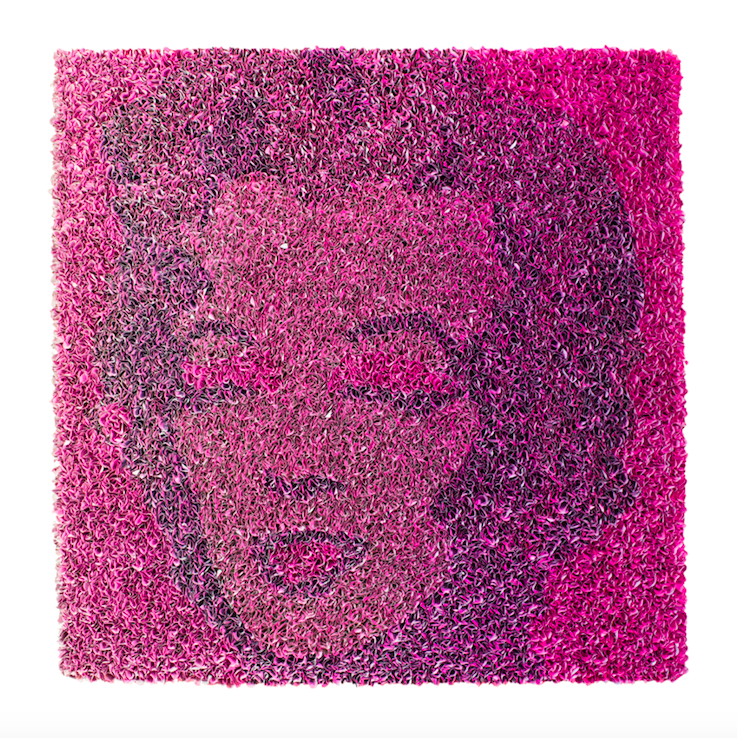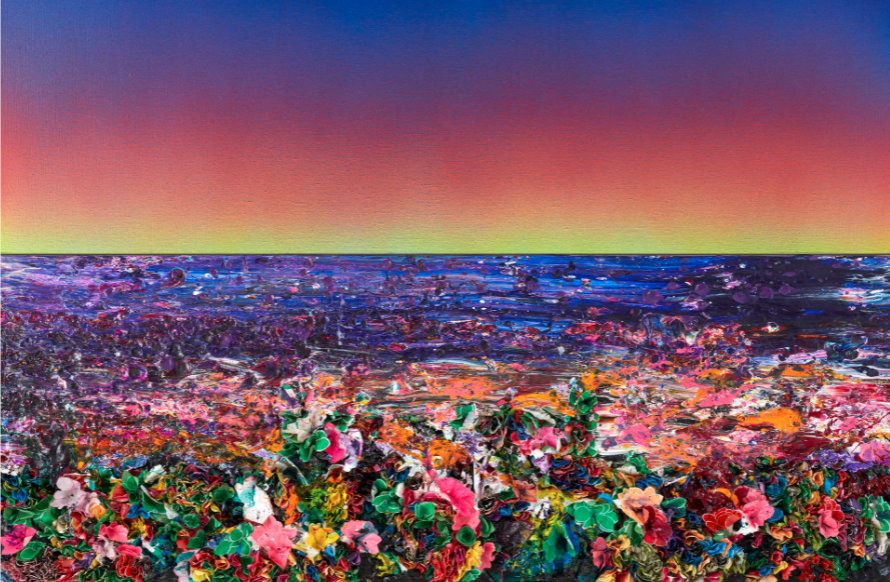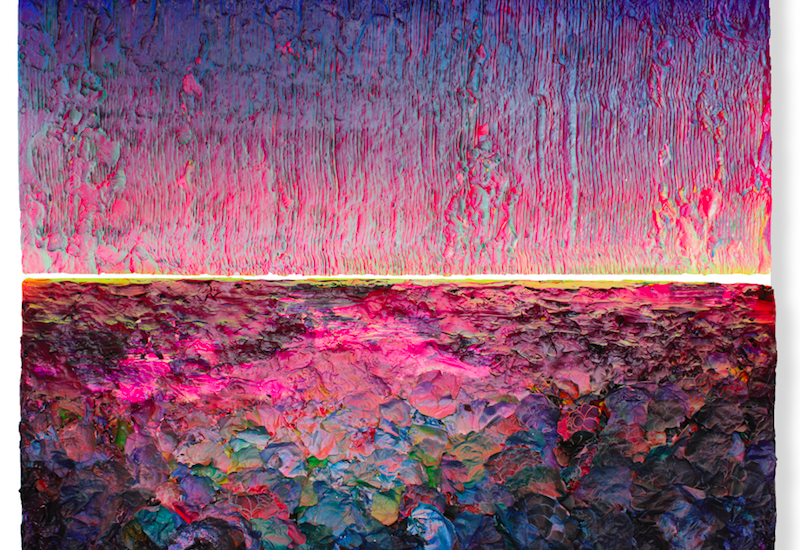Thousands of hand-folded colored pieces of rice paper hypnotize you as you wander past one of Zhuang Hong Yi’s works. You remember when you have beheld one. You feel as if you are bobbing on a sea of brilliance as you pace back and forth, striving to catch a glimpse of precisely where one color blends in with another within its rhythmic, captivating, protean elegance.
The flowerbed pieces are made of carefully folded rice paper that creates a layered structure reflecting light from multiple layers, delivering constructive and destructive interference for different colors. The interferences make the colors vary at different angles, creating a playful, chromatic and very invigorating experience.
His canvases, thickly coated, reach the observer in elegant colors, vibrant purples, corals and magentas, and alluring azures. His works call out to your senses for engagement. Zhuang has brought to life a lush, captivating experience. You want to inhale the savory colors or become small enough to perhaps roll about within one. The works are distinct and possess a voice all their own, as does the artist who gave us an inside look into his creative process and where it all began.
It would be necessary to note in this article; there are three pictures of some of the unique works, which are all the same painting from various viewpoints to reveal appearance transitions and depth.
DP- Your works sometimes have thousands of traditional fine Chinese rice paper, which you cut and plant by hand to create the lotus flowers. How long does it take to create your flower beds?
ZHY- It takes around 4-6 weeks from scratch to completely finish a flowerbed piece.
DP- Your landscapes are almost like scenes out of movies. Do you first take references from a particular place you have visited, or do you create them as you go and in reference to your feelings of the moment?
ZHY– I always find inspirations whilst traveling. Not only from nature but also from bright or unique colors I sometimes observe in my environment.

Photo Courtesy of the Artists Studio

Left and right View of the above work. Photo courtesy of the artists studio
DP- Your father was a writer, how did his literature and living in a creative environment influence your craft?
ZHY- I think that it definitely has had some influence, but only in regards to sparking interest in art and literature when I was growing up.
DP- When did you first begin to create art?
ZHY- There has not been an exact point in my life since I started to make art, as I always like drawing and making things since I was a kid. But I would say that I really started to get serious with art at the age of 20 when I started to study at Sichuan Fine Arts Institute in 1982.

Photo Courtesy of the artists studio


DP- What guided you to move to Holland? Why there?
ZHY- I moved to the Netherlands in 1992 to study at the Minerva Art Academy. I always knew about the famous Dutch artists such as Rembrandt, Mondriaan, and Van Gogh, so I saw the Netherlands as a very good place to start my career as a professional artist.
DP- You are represented by an assortment of galleries, where many artists choose to work with one. Do you believe this has proven better for you?
ZHY- I definitely do think that working with multiple galleries is better than working with just one gallery. Not only do you get represented in more countries across the world, but you also get to know the International Art Market better. Another reason for me to not work with just one gallery is that I do not want to be a dependent artist. I am very careful at choosing the galleries that represent my work. I find it very important that I can create a good relationship with the gallery owners and their teams. I am very proud to be able to say that throughout the last decennium, I have created good and fruitful relationships with all the current galleries I am collaborating with.
DP- You lay it on thick with the paint! (It is so much fun to watch you.) The density and smoothness of it are almost like gorgeous pink and colored frosting on a cake. How long does it usually take to dry?
ZHY– Yes, it is one of the most fun and satisfying stages of creating a piece! The thick layers of acrylic usually take around 2 weeks to dry.

Center, Left and right View of the above work. Photo courtesy of the artists studio
DP- You seem to push boundaries in not only creating works that are 3D but also flawlessly change color as one walks by them from one end to the other. Tell me about that inner dialogue and patience one has to create such intricate work.
ZHY- When you think of it, the idea is quite simple; creating an artwork that changes color. But it was only during the last couple of years of my more 30 years career as an artist during which I really discovered it. And the idea certainly did not just pop into my head. The color-changing flowerbeds gradually became what they are now throughout many years of making them. I discovered new things one step at a time and all the new discoveries piling up have led to the result you see now. Even now, I am constantly discovering new things and I always strive to make the paintings better than they are at the moment. It is a never-ending journey. The inner dialogue would be patience and discipline.

Picture courtesy of the Unit London
DP- How well does it feel to work on large works? As opposed to smaller ones?
ZHY–Making a large-scale painting is very different than making a small-scale painting. But both have their own up- and downsides. With a larger scale painting, I really need to have a lot of energy in order to create an impactful piece. So I can not make them on a regular basis as I need to recharge my energy once in a while. Once making them, it feels like escaping to a world full of color where I can bring my ideas to reality. Smaller-scale paintings take less time and energy to make, so that is why I mostly make smaller-scale paintings. They often do require more precision.
DP- I love how you were inspired by the flower fields in Holland, and add traditional Chinese flowers in the representation of both places. What was it like for you the first time you sold one?
ZHY- My art from when I first came to Holland is very different from now. At the first stage, the flower was not represented at all in my art. Eventually, I started to use them here and there in my paintings and over the years my paintings became flowerbeds. So it is hard to say which piece was officially the first flowerbed piece. I do remember a show I did with a gallery in Belgium, during which I exhibited only flowerbeds for the first time. It was a very successful exhibition, which of course made me very happy and glad as I put a lot of effort not only in creating the flowerbeds but mostly in creating the idea of a flowerbed. At that point, I realized that I was onto something special.

Photo Courtesy of the artists studio
DP- Who bought your first painting? Was it in China or elsewhere?
ZHL- I sold my first painting in 1986 in China to an American professor. He bought it during an exhibition that was organized by the Art Institute of Sichuan.
DP- Your art is well spread out around the globe, and so unique! Who encouraged you/ helped get you started in the art world?
ZHL- Moving to the Netherlands in 1992, I left everything behind me in China in order to persuade a career as an artist. My wife Lu Luo moved to the Netherlands two years later as well, she definitely has been the most important person for my career. Together, we struggled for a lot of years as professional artists, but we always succeeded to keep persuading our dreams and not give up.

Photo Courtesy of the Unit, London
DP- What do you cherish most about your time in the Netherlands?
ZHL- The freedom and acceptance, the people, and the fact that everyone speaks English in the Netherlands are some of the many things I cherish the most about the country. Also, its geographical location, as it is very well located in Europe, has definitely helped me in becoming more international.
DP- What are you looking forward to?
ZHL- I look forward to bringing all the (artistic) ideas that I have to life!






